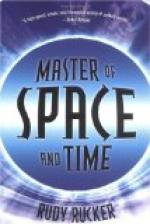Credit for the first suggestion of an electric telegraph must be given to an unknown writer of the middle eighteenth century. In the Scots Magazine for February 17, 1755, there appeared an article signed simply, “C.M.,” which suggested an electric telegraph. The writer’s idea was to lay an insulated wire for each letter of the alphabet. The wires could be charged from an electrical machine in any desired order, and at the receiving end would attract disks of paper marked with the letter which that wire represented, and so any message could be spelled out. The identity of “C.M.” has never been established, but he was probably Charles Morrison, a Scotch surgeon with a reputation for electrical experimentation, who later emigrated to Virginia. Of course “C.M.’s” telegraph was not practical, because of the many wires required, but it proved to be a fertile suggestion which was followed by many other thinkers. One experimenter after another added an improvement or devised a new application.
A French scientist devised a telegraph which it is suspected might have been practical, but he kept his device secret, and, as Napoleon refused to consider it, it never was put to a test. An Englishman devised a frictional telegraph early in the last century and endeavored to interest the Admiralty. He was told that the semaphore was all that was required for communication. Another submitted a similar system to the same authorities in 1816, and was told that “telegraphs of any kind are now wholly unnecessary.” An American inventor fared no better, for one Harrison Gray Dyar, of New York, was compelled to abandon his experiments on Long Island and flee because he was accused of conspiracy to carry on secret communication, which sounded very like witchcraft to our forefathers. His telegraph sent signals by having the electric spark transmitted by the wire decompose nitric acid and so record the signals on moist litmus paper. It seems altogether probable that had not the discovery of electro-magnetism offered improved facilities to those seeking a practical telegraph, this very chemical telegraph might have been put to practical use.
In the early days of the nineteenth century the battery had come into being, and thus a new source of electric current was available for the experimenters. Coupled with this important discovery in its effect upon the development of the telegraph was the discovery of electro-magnetism. This was the work of Hans Christian Oersted, a native of Denmark. He first noticed that a current flowing through a wire would deflect a compass, and thus discovered the magnetic properties of the electric current. A Frenchman named Ampere, experimenting further, discovered that when the electric current is sent through coils of wire the magnetism is increased.
The possibility of using the deflection of a magnetic needle by an electric current passing through a wire as a means of conveying intelligence was quickly grasped by those who were striving for a telegraph. Experiments with spark and chemical telegraphs were superseded by efforts with this new discovery. Ampere, acting upon the suggestion of La Place, an eminent mathematician, published a plan for a feasible telegraph. This was later improved upon by others, and it was still early in the nineteenth century that a model telegraph was exhibited in London.




